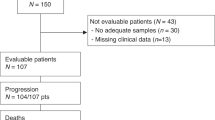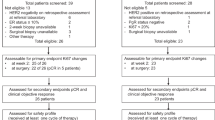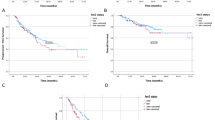Abstract
Metastatic breast cancer (MBC) is essentially incurable despite recent improvements in systemic therapies. We often encounter difficulties in choosing the most appropriate treatments, with optimal timing, for individual patients. Everolimus, one of the mTOR inhibitors, is usually used with endocrine therapy for MBC. Identification of predictive markers for everolimus-based treatment remains a major issue, but to date, no predictive markers have been established. We retrospectively investigated predictive markers for treatments with everolimus plus exemestane in patients with ER-positive and HER2-negative breast cancer. Clinicopathological features of 18 patients, with locally advanced disease or MBC given everolimus plus exemestane treatments, were examined in relation to treatment effects. Also, primary breast cancer specimens, all ER positive and HER2 negative, were immunohistochemically investigated for phospho-S6 (pS6) and PTEN, to evaluate the mTOR and PIK3CA/Akt pathways. Those showing a good clinical response had a significantly lower Ki67 labeling index than the poor responders. A similar trend was observed in pS6 level but without statistical significance. Interestingly, there was no correlation between the Ki67 labeling index and pS6, and when both indexes were low, the good clinical response rate was high. The median progression-free survival was longer in the group showing a low Ki67 labeling index (109 weeks) than in that with high Ki67 (19 weeks). There was no trend between PTEN expression and treatment effects. Our results suggest that the primary tumor in luminal HER2-negative breast cancer patients with a low Ki67 labeling index and pS6 level has the potential to respond well to everolimus plus exemestane.



Similar content being viewed by others
References
Coates AS, Winer EP, Goldhirsch A, Gelber RD, Gnant M, Piccart-Gebhart M, Thürlimann B, Senn HJ. Tailoring therapies—improving the management of early breast cancer: St Gallen International Expert Consensus on the Primary Therapy of Early Breast Cancer 2015. Ann Oncol. 2015;26:1533–46.
Horimoto Y, Arakawa A, Tanabe M, Sonoue H, Igari F, Senuma K, Tokuda E, Shimizu H, Kosaka T, Saito M. Ki67 expression and the effect of neo-adjuvant chemotherapy on luminal HER2-negative breast cancer. BMC Cancer. 2014;14:550.
Dowsett M, Ebbs SR, Dixon JM, Skene A, Griffith C, Boeddinghaus I, Salter J, Detre S, Hills M, Ashley S, Francis S, Walsh G, Smith IE. Biomarker changes during neoadjuvant anastrozole, tamoxifen, or the combination: influence of hormonal status and HER-2 in breast cancer—a study from the IMPACT trialists. J Clin Oncol. 2005;23:2477–92.
Ellis MJ, Tao Y, Luo J, A’Hern R, Evans DB, Bhatnagar AS, Chaudri Ross HA, von Kameke A, Miller WR, Smith I, Eiermann W, Dowsett M. Outcome prediction for estrogen receptor-positive breast cancer based on postneoadjuvant endocrine therapy tumor characteristics. JNCI J Natl Cancer Inst. 2008;100:1380–8.
Dowsett M, Smith IE, Ebbs SR, Dixon JM, Skene A, A’Hern R, Salter J, Detre S, Hills M, Walsh G. Prognostic value of Ki67 expression after short-term presurgical endocrine therapy for primary breast cancer. JNCI J Natl Cancer Inst. 2007;99:167–70.
Selli C, Dixon JM, Sims AH. Accurate prediction of response to endocrine therapy in breast cancer patients: current and future biomarkers. Breast Cancer Res BCR. 2016;18:118.
Yamnik RL, Digilova A, Davis DC, Brodt ZN, Murphy CJ, Holz MK. S6 kinase 1 regulates estrogen receptor α in control of breast cancer cell proliferation. J Biol Chem. 2009;284:6361–9.
Magnuson B, Ekim B, Fingar DC. Regulation and function of ribosomal protein S6 kinase (S6K) within mTOR signalling networks. Biochem J. 2012;441:1–21.
Bärlund M, Forozan F, Kononen J, Bubendorf L, Chen Y, Bittner ML, Torhorst J, Haas P, Bucher C, Sauter G, Kallioniemi O-P, Kallioniemi A. Detecting activation of ribosomal protein S6 kinase by complementary DNA and tissue microarray analysis. JNCI J Natl Cancer Inst. 2000;92:1252–9.
Houghton PJ. Everolimus. Clinical Cancer Res. 2010;16:1368–72.
Sansal I, Sellers WR. The biology and clinical relevance of the PTEN tumor suppressor pathway. J Clin Oncol. 2004;22:2954–63.
Baselga J, Campone M, Piccart M, Burris HAI, Rugo HS, Sahmoud T, Noguchi S, Gnant M, Pritchard KI, Lebrun F, Beck JT, Ito Y, Yardley D, Deleu I, Perez A, Bachelot T, Vittori L, Xu Z, Mukhopadhyay P, Lebwohl D, Hortobagyi GN. Everolimus in postmenopausal hormone-receptor–positive advanced breast cancer. N Engl J Med. 2012;366:520–9.
André F, O’Regan R, Ozguroglu M, Toi M, Xu B, Jerusalem G, Masuda N, Wilks S, Arena F, Isaacs C, Yap Y-S, Papai Z, Lang I, Armstrong A, Lerzo G, White M, Shen K, Litton J, Chen D, Zhang Y, Ali S, Taran T, Gianni L. Everolimus for women with trastuzumab-resistant, HER2-positive, advanced breast cancer (BOLERO-3): a randomised, double-blind, placebo-controlled phase 3 trial. Lancet Oncol. 2014;15:580–91.
Royce ME, Osman D. Everolimus in the treatment of metastatic breast cancer. Breast Cancer Basic Clin Res. 2015;9:73–9.
Kornblum N, Manola J, Klein P, Ramaswamy B, Brufsky A, Stella P, Burnette B, Telli M, Makower D, Leach J, Truica C, Wolff A, Soori G, Haley B, Nagarajan A, Wassenaar T, Goldstein L, Miller K, Sparano J. Abstract S1-02: PrECOG 0102: a randomized, double-blind, phase II trial of fulvestrant plus everolimus or placebo in post-menopausal women with hormone receptor (HR)-positive, HER2-negative metastatic breast cancer (MBC) resistant to aromatase inhibitor (AI) therapy. Cancer Res. 2017;77:S1–02.
Pópulo H, Lopes JM, Soares P. The mTOR signalling pathway in human cancer. Int J Mol Sci. 2012;13:1886–918.
Wander SA, Hennessy BT, Slingerland JM. Next-generation mTOR inhibitors in clinical oncology: how pathway complexity informs therapeutic strategy. J Clin Investig. 2011;121:1231–41.
Treilleux I, Arnedos M, Cropet C, Wang Q, Ferrero JM, Abadie-Lacourtoisie S, Levy C, Legouffe E, Lortholary A, Pujade-Lauraine E, Bourcier AV, Eymard JC, Spaeth D, Bachelot T. Translational studies within the TAMRAD randomized GINECO trial: evidence for mTORC1 activation marker as a predictive factor for everolimus efficacy in advanced breast cancer. Ann Oncol. 2015;26:120–5.
Eisenhauer EA, Therasse P, Bogaerts J, Schwartz LH, Sargent D, Ford R, Dancey J, Arbuck S, Gwyther S, Mooney M, Rubinstein L, Shankar L, Dodd L, Kaplan R, Lacombe D, Verweij J. New response evaluation criteria in solid tumours: revised RECIST guideline (version 1.1). Eur J Cancer. 2009;45:228–47.
Goulon D, Necib H, Henaff B, Rousseau C, Carlier T, Kraeber-Bodere F. Quantitative evaluation of therapeutic response by FDG-PET–CT in metastatic breast cancer. Front Med. 2016;3:19.
Zardavas D, Phillips WA, Loi S. PIK3CA mutations in breast cancer: reconciling findings from preclinical and clinical data. Breast Cancer Res BCR. 2014;16:201.
Ellis MJ, Lin L, Crowder R, Tao Y, Hoog J, Snider J, Davies S, DeSchryver K, Evans DB, Steinseifer J, Bandaru R, Liu W, Gardner H, Semiglazov V, Watson M, Hunt K, Olson J, Baselga J. Phosphatidyl-inositol-3-kinase alpha catalytic subunit mutation and response to neoadjuvant endocrine therapy for estrogen receptor positive breast cancer. Breast Cancer Res Treat. 2010;119:379–90.
Beelen K, Opdam M, Severson TM, Koornstra RHT, Vincent AD, Wesseling J, Muris JJ, Berns EMJJ, Vermorken JB, van Diest PJ, Linn SC. PIK3CA mutations, phosphatase and tensin homolog, human epidermal growth factor receptor 2, and insulin-like growth factor 1 receptor and adjuvant tamoxifen resistance in postmenopausal breast cancer patients. Breast Cancer Res BCR. 2014;16:R13.
André F, Hurvitz S, Fasolo A, Tseng L-M, Jerusalem G, Wilks S, O’Regan R, Isaacs C, Toi M, Burris H, He W, Robinson D, Riester M, Taran T, Chen D, Slamon D. Molecular alterations and everolimus efficacy in human epidermal growth factor receptor 2-overexpressing metastatic breast cancers: combined exploratory biomarker analysis from BOLERO-1 and BOLERO-3. J Clin Oncol. 2016;34:2115–24.
Loi S, Michiels S, Baselga J, Bartlett JMS, Singhal SK, Sabine VS, Sims AH, Sahmoud T, Dixon JM, Piccart MJ, Sotiriou C. PIK3CA genotype and a PIK3CA mutation-related gene signature and response to everolimus and letrozole in estrogen receptor positive breast cancer. PLoS ONE. 2013;8:e53292.
Amir E, Miller N, Geddie W, Freedman O, Kassam F, Simmons C, Oldfield M, Dranitsaris G, Tomlinson G, Laupacis A, Tannock IF, Clemons M. Prospective study evaluating the impact of tissue confirmation of metastatic disease in patients with breast cancer. J Clin Oncol. 2012;30:587–92.
Criscitiello C, André F, Thompson AM, De Laurentiis M, Esposito A, Gelao L, Fumagalli L, Locatelli M, Minchella I, Orsi F, Goldhirsch A, Curigliano G. Biopsy confirmation of metastatic sites in breast cancer patients: clinical impact and future perspectives. Breast Cancer Res BCR. 2014;16:205.
Author information
Authors and Affiliations
Corresponding author
Ethics declarations
Conflict of interest
The authors declare that they have no conflict of interest.
Electronic supplementary material
Below is the link to the electronic supplementary material.
12032_2018_1112_MOESM2_ESM.pptx
Supplementary figure 1. Representative images of pS6 and PTEN immunohistochemistry. Representative images of pS6 (stained in the cytoplasm) and PTEN (stained on cell membrane) immunohistochemistry are shown. Supplementary figure 2. Kaplan-Meier curve for PFS of the 18 patients. The median PFS was 21 weeks. Supplementary figure 3. The scatter diagram for the Ki67 labelling index and pS6. The scatter diagram revealed that there was no correlation between the Ki67 labelling index and pS6 expression, with the correlation coefficient being -0.06 (PPTX 2982 kb)
Rights and permissions
About this article
Cite this article
Okazaki, M., Horimoto, Y., Tanabe, M. et al. Predictive markers for efficacy of everolimus plus exemestane in patients with luminal HER2-negative metastatic breast cancer. Med Oncol 35, 48 (2018). https://doi.org/10.1007/s12032-018-1112-9
Received:
Accepted:
Published:
DOI: https://doi.org/10.1007/s12032-018-1112-9




